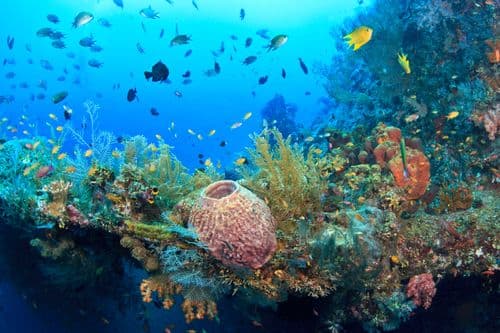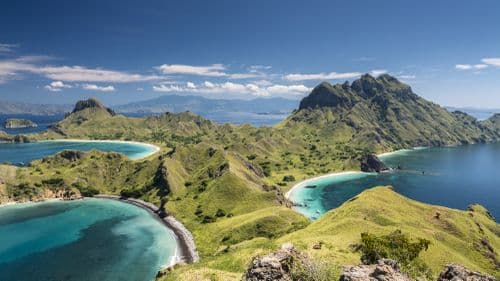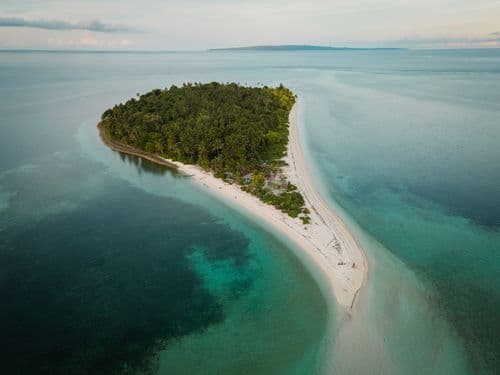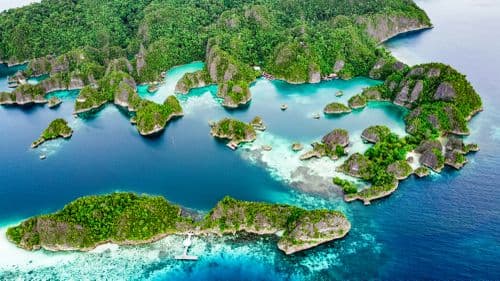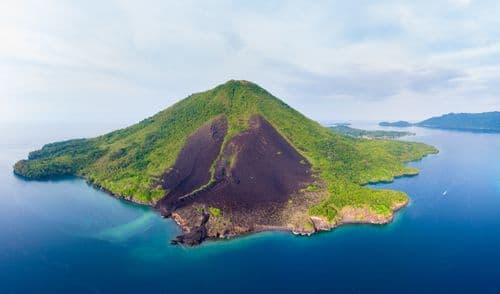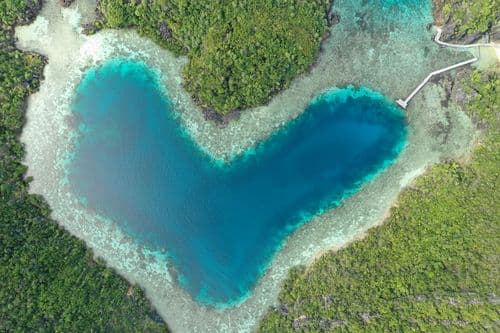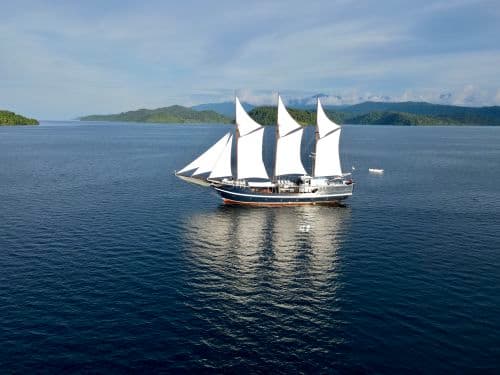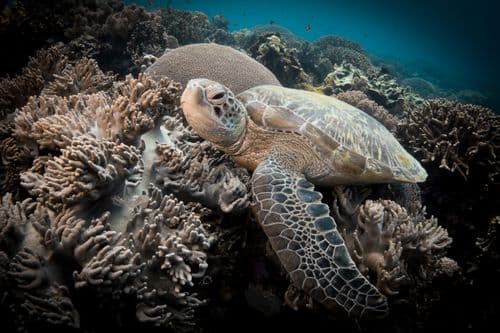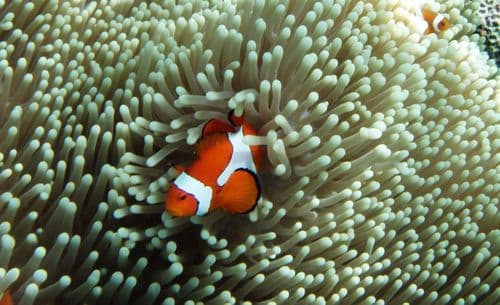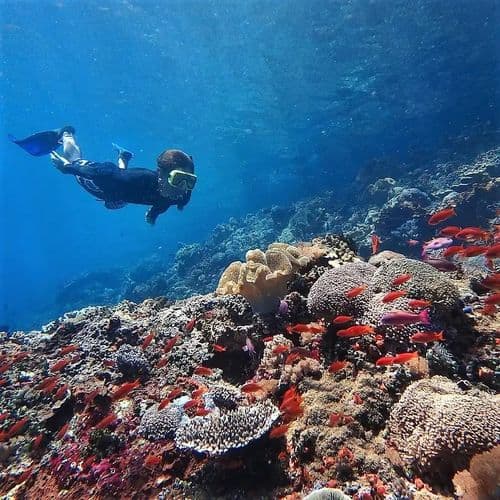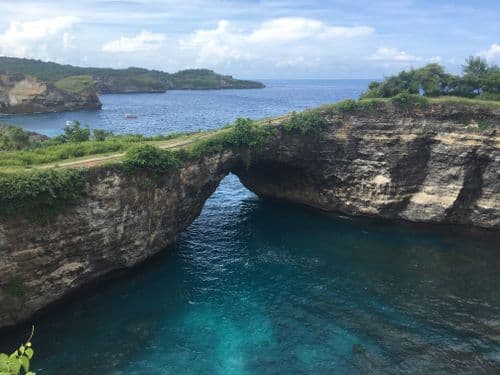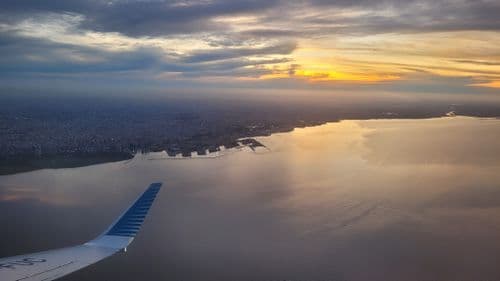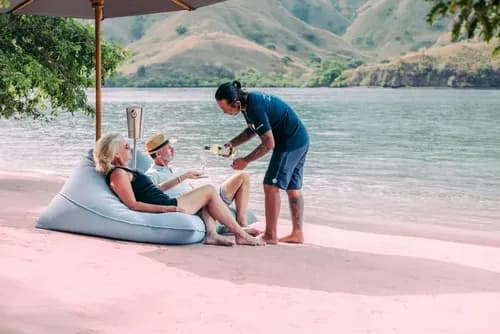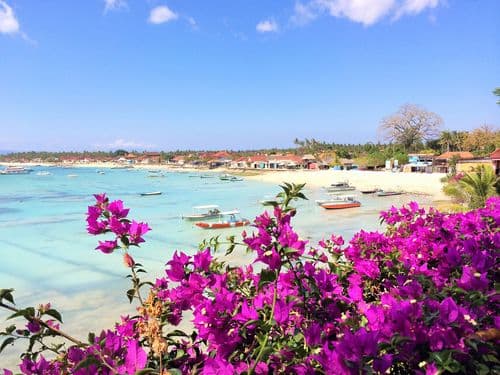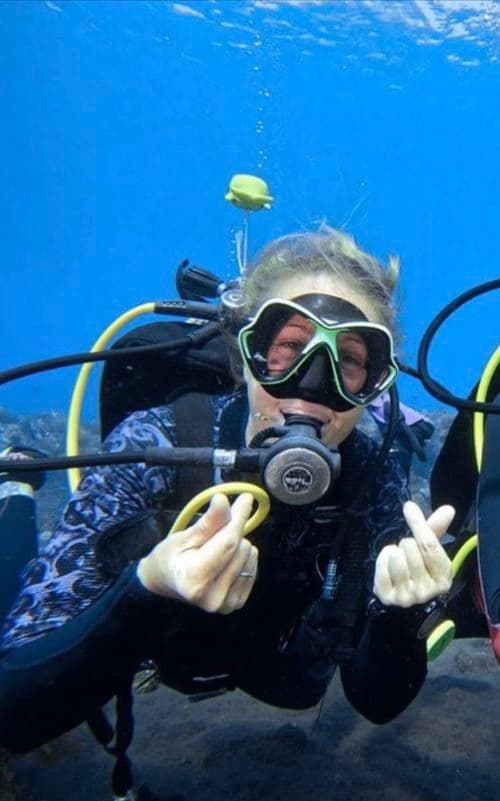
Ambon–Banda Sea–Raja Ampat
A 12-day long trip on board the Mermaid I
Length
12 Days
Ship category
Premium
Ship type
Small Ship
Capacity
15 Passengers
Raja Ampat-Banda Sea-Ambon
1 Review
Trip highlights
Eat breakfast at a nutmeg plantation
Dive with Chinese sea snakes and banded sea kraits
Visit a traditional Papuan village
Enjoy tender rides through amazing inner lagoons
The DiveIndonesia experience
Personalized and intimate dive experiences
Spacious dive deck and comfortable camera room
Air-conditioned cabins with ocean views
Delicious meals prepared by an expert chef
This trip is a 12-day expedition that promises an unparalleled adventure, both above and below water. With approximately 33 dives in total, you will explore some of the most iconic dive sites in Raja Ampat, Banda Sea, and Ambon.
This adventure offers an unmatched diversity of underwater experiences, from the the vibrant coral reefs of Raja Ampat to the muck diving wonders of Ambon Bay. Ideal for divers of all levels, the trip includes opportunities to dive historic shipwrecks, swim with manta rays, and discover vibrant coral gardens teeming with marine life.
Expect water temperatures between 27-30°C (81-86°F) and visibility ranging from 15-40 meters (50-130 feet). A 3mm wetsuit is recommended for optimal comfort. Non-divers can enjoy snorkeling, kayaking, and beach excursions, ensuring an enriching experience for everyone on board.
Your ship: Mermaid 1



We adore Mermaid I for its superb blend of luxury and top-notch diving experiences across Indonesia's premier dive sites. Built to enhance diver comfort and enjoyment, Mermaid I consistently delivers unforgettable adventures, whether you're exploring the rich biodiversity of Raja Ampat or the thrilling underwater landscapes of Komodo.
Imagine starting your day with a breathtaking view of the ocean, ready to dive into some of the world's most spectacular marine environments. The Mermaid I offers a variety of itineraries that cover Indonesia's iconic diving destinations, including the Coral Tri … Read more about Mermaid 1
Cabins




Amenities
Transfers to and from ship
Bar
Wetsuits (can be rented)
Snorkel gear (free of charge)
Complete set of Scuba gear (approx 250 USD)
Kayaks on board
All meals
Laundry service
Air conditioning & private bathroom
Single travellers can share cabin
Water, Coffee, Tea & fresh juices
TV in room
Library
Nitrox fills (appprox. 150 USD)
Internet/Wifi
Food & Drinks
Indulge in delicious cuisine prepared with fresh, locally sourced ingredients. The onboard "Sawasdee Restaurant" offers a mix of Indonesian and Western dishes, served buffet-style, ensuring there’s something for everyone. Enjoy a sumptuous BBQ or relax in the saloon post-meal, complete with a multimedia entertainment center and an extensive marine life library.
Map
Itinerary
Your itinerary below may vary, depending on the weather, wildlife breeding, and local conditions.
Day 1
Sorong



Check-in time in Sorong is between 07.00 am - 14.00.
Check-in on board MV Mermaid I. As the guest arrivals take place all through the day depending on flights, you are welcome to board when you arrive and spend some time unpacking and setting up your equipment, etc.
Following the boat and safety briefing, Mermaid I will cruise for 5 to 6 hours to the Dampier Strait, 40 nautical miles.
Day 2-3
Dampier Strait



The next two days will be spent around the Dampier Strait, the strait between the island of Waigeo, the Bird’s Head Peninsula and the northern side of Batanta Island.
The Dampier Strait is known for a huge variety of diving, from giant mantas to mangroves, beautiful reefs, many pinnacles and sea mounts covered in schooling fish, aggregations of sweetlips, schooling barracudas, bumphead parrotfish, fusiliers and lots of wobbegong sharks. It is also a great location for critters and macro subjects, with several species of pygmy seahorses and a large variety of nudibranchs.
There are also several jetties to do some great night dives, where you can see Raja epaulette sharks, toadfish, frogfish and crocodile fish.
Cruise overnight to Misool, 90 nautical miles.
Day 4-6
Misool



The next three days will be spent around the island of Misool, where there are literally hundreds of dive sites. Misool is heaven for wide angle photographers. The prettiest soft coral reefs in the world are located in Misool. In addition, there are multiple pinnacles surrounded by masses of schooling fish, barracudas, jacks and snappers.
There will be some excursions with the tenders through some amazing inner lagoons, with fantastic scenery and wildlife sightings.
Cruise overnight to Pulau Koon, 100 nautical miles.
Day 7
Koon



Pulau Koon is a small island on the southeast of Ceram, half way between Raja Ampat and the Banda Islands. Here you will find walls covered in soft corals and sandy slopes with hard coral bommies. But the most interesting feature of this island is the amount of schooling fish and pelagics, including barracudas, bigeye trevallies, aggregations of red snappers, pompanos, batfish and giant groupers.
Cruise overnight to Manuk, 108 nautical miles.
Day 8
Manuk



Manuk, an active volcano about 55 nautical miles south of the Banda Islands, is one of two places in Indonesia where there are huge aggregations of sea snakes: Chinese sea snakes and banded sea kraits. It is an incredible experience to dive, surrounded on all sides by sea snakes. The island is surrounded by black sandy slopes with hard coral reefs and volcanic ridges covered in gorgonians with zillions of fusiliers and pelagic fishes such as Spanish mackerels and dogtooth tunas passing through.
Cruise overnight to the Banda Islands, 55 nautical miles.
Day 9-10
Banda Islands - Banda Neira



The next two days will be spent in the Banda Islands, formerly known as the Spice Islands. Many of the dive sites around the Banda islands are wall dives. The walls are covered in massive gorgonians, soft corals, barrel sponges and have some very interesting swim throughs. But there are other attractive dive sites such as pinnacles with enormous groups of schooling pyramid butterflyfish, triggerfish and pelagic fishes such as tunas passing through, spectacular hard coral reefs next to the volcano, and great muck dives with lots of mandarin fish at the local jetty.
The Banda Islands are much more than diving. It is also a cultural and historical experience. You will spend one morning walking around the village of Banda Neira the main island, with a local guide, visiting the local museum, the old Dutch fort, the old colonial governor’s house, the local fish market and a nutmeg plantation, where you will have breakfast.
Cruise overnight to Nusa Laut (77 nautical miles) or to Ambon (110 nautical miles).
Day 11
Nusa Laut - Ambon



The last diving day of the trip will be around either the island of Nusa Laut or in Ambon Bay. Nusa Laut is a small island, next to the island of Saparua, which has some beautiful hard coral fringing reefs as well as walls similar to those of the Banda Islands.
Or, you will spend the day around Ambon, where there are several options such as wrecks, caves or some really interesting muck dives looking for Rhinopias, frogfish (including the psychedelic frogfish), harlequin shrimps and many other critters.
Dates & Prices
From
Until
Info
Availability
Price
6
Apr
2025
17
Apr
2025
From
EUR 5,002
6
Apr
2025
17
Apr
2025
From
EUR 5,002
1
Apr
2026
12
Apr
2026
From
EUR 5,002
1
Apr
2026
12
Apr
2026
From
EUR 5,002
Preferred date unavailable? Contact us
Info
Single Cabin Supplement
When booking online, you can choose the option to "Upgrade to single occupancy". This will guarantee you the whole cabin to yourself, for an additional fee. If you don't select this option, then another traveler of the same sex might be placed into the same cabin with you.
What's included
Transfers from/to airport at the free of charge points
all meals & snacks, coffee, tea, hot chocolate, soft drinks and drinking water
tanks
weights, weight belts
diving with experienced dive masters/Instructors
What's not included
Transfers outside the free of charge zones
National park/port fees:
For 2024 park/port fees for all cruises are EUR 225
For 2025 onwards, park/port fees for all cruises are EUR 275
Fuel Surcharges if applicable
Nitrox fills (around 175 EUR)
rental equipment
onboard courses
dive insurance (Mandatory)
massages
souvenirs
alcoholic beverages
Reviews
Worth Knowing
Divers need to be a minimum of Open Water Diver with at least of 4 completed dives or higher diving certification to join the vessel for diving.
There is no liquor available on board, but you can bring your own. Beer is EURO 3 per can and wine is EURO 30 per bottle.
Park fees and port fees, alcoholic drinks, massages, nitrox, and any extra purchases have to be paid onboard directly.
You can pay all onboard costs in € Euros, $ USD or Indonesian Rupiah. They also accept credit card payments with Visa and Mastercard.
Many of our guests use 5-10% of the cruise price as a tipping guideline. Tipping is voluntary and most appreciated!
FAQs
What are the different levels of dive certifications required for diving in Indonesia?
Diving in Indonesia offers a spectacular array of underwater experiences, catering to both novice and experienced divers. Here's a breakdown of the different dive certification levels you might need:
- Open Water Diver (OWD): This is the entry-level certification that allows you to dive up to 18 meters (60 feet) under the supervision of a dive professional. Ideal for exploring many of Indonesia’s stunning reefs and beginner-friendly dive sites.
- Advanced Open Water Diver (AOWD): Recommended for those looking to extend their diving skills and dive deeper, up to 30 meters (100 feet). This certification opens up more challenging dive sites in Indonesia, including some of the more famous dive spots in Komodo National Park and Raja Ampat.
- Rescue Diver: This certification is for those wanting to improve their safety and emergency response skills. It’s highly recommended for divers looking to undertake more adventurous dives.
- Divemaster: The first professional level, allowing you to lead certified divers. This is perfect for those looking to make a career out of diving or wanting to gain a deep understanding of dive planning and marine environments.
Where can I obtain dive certifications in Indonesia?
Indonesia is home to numerous world-class dive schools and resorts offering a range of certification courses. Here are some top recommendations:
- Bali: Renowned for its excellent dive training facilities, Bali offers everything from Open Water to Divemaster courses. Popular spots include Padang Bai and Amed.
- Gili Islands: Known for vibrant marine life and clear waters, the Gili Islands are a fantastic place to get certified. Many dive centers here offer courses in multiple languages.
- Komodo: For those already holding an Open Water certification, Komodo offers advanced training opportunities with its thrilling currents and diverse dive sites.
- Raja Ampat: While more remote, Raja Ampat provides unparalleled diving experiences and advanced training in one of the world's most biodiverse marine environments.
Do I need an advanced certification to dive in Indonesia?
While an Open Water certification is sufficient for many dive sites in Indonesia, an Advanced Open Water certification is highly recommended. This allows you to dive deeper and access more challenging and rewarding dive sites. It’s especially beneficial for exploring areas with stronger currents or deeper reefs.
What should I consider when choosing a dive school in Indonesia? When selecting a dive school, consider the following:
- Certification Agency: Ensure the school is affiliated with a recognized certification agency like PADI or SSI.
- Instructor Experience: Look for experienced instructors with a good track record of safety and student success.
- Class Sizes: Smaller class sizes often mean more personalized attention and a better learning experience.
- Equipment Quality: Check that the school uses well-maintained and up-to-date diving equipment.
- Reviews and Recommendations: Read reviews and seek recommendations from fellow divers to ensure a reputable and enjoyable learning experience.
Can I get certified before my trip to Indonesia?
Absolutely! Many divers prefer to complete their theory and pool sessions at home and finish their open water dives in the crystal-clear waters of Indonesia. This option, known as a referral course, allows you to maximize your vacation time enjoying the incredible marine life.
With a range of certification levels and top-notch dive schools, Indonesia is an ideal destination for divers of all abilities. Whether you’re just starting out or looking to advance your skills, the underwater wonders of Indonesia await you.
For more detailed advice and personalized recommendations, feel free to contact us! Happy diving!
How much is my down payment, what's the cancellation policy?
Please see our complete Terms and Conditions where you will find our detailed payment and cancellation policies.
Do I Need Dive Insurance for My Indonesia Liveaboard Trip?
Diving in Indonesia offers unparalleled underwater experiences, from the vibrant reefs of Raja Ampat to the thrilling currents of Komodo. However, with these adventures comes the need for proper protection. Dive insurance is essential for any diver exploring Indonesia’s waters, ensuring peace of mind and safety in case of emergencies. Here’s everything you need to know about dive insurance, why it’s important, what it should cover, and our recommended provider.
Why Dive Insurance is Important
Diving is an adventurous activity that, while generally safe, carries inherent risks. Unexpected incidents such as decompression sickness, marine life injuries, or equipment failures can occur. Dive insurance provides coverage for medical treatments, emergency evacuations, and other dive-related incidents that could otherwise result in significant expenses. Without insurance, divers might face substantial out-of-pocket costs for medical care, hyperbaric chamber treatments, or emergency evacuations, especially in remote locations.
What Dive Insurance Should Cover
When selecting dive insurance, it’s crucial to ensure that your policy provides comprehensive coverage tailored to diving activities. Here are the key elements your dive insurance should include:
- Emergency Medical Expenses: Coverage for treatments related to diving injuries, including decompression sickness and other dive-related medical conditions.
- Hyperbaric Chamber Treatments: Costs for hyperbaric chamber use, essential for treating decompression sickness.
- Emergency Evacuation and Repatriation: Coverage for air or sea evacuation to the nearest appropriate medical facility and transportation back home if necessary.
- Dive Equipment Loss or Damage: Protection for your valuable diving gear in case of loss, theft, or damage.
- Trip Cancellation or Interruption: Reimbursement for prepaid dive trips or courses if you need to cancel or cut your trip short due to unforeseen circumstances.
- Personal Liability: Coverage for legal liability in case you accidentally cause injury to others or damage property while diving.
Recommended Dive Insurance Provider
At DiveIndonesia, we only work with trusted insurance providers to ensure our clients receive the best coverage. Our recommended provider is DiveAssure, a leading specialist in dive insurance. DiveAssure offers comprehensive policies specifically designed for divers, providing extensive coverage and peace of mind.
Why Choose DiveAssure?
- Specialized Coverage: DiveAssure’s policies are tailored to meet the unique needs of divers, offering extensive coverage for diving-related incidents.
- Global Network: Access to a worldwide network of hyperbaric chambers and medical facilities experienced in treating dive injuries.
- 24/7 Assistance: Immediate support and assistance available around the clock, ensuring help is just a call away.
- Flexible Plans: Various plans to suit different diving activities, from recreational diving to technical diving and liveaboard trips.
- Quick Claims Process: Efficient and hassle-free claims process, ensuring you receive the support you need promptly.
Practical Tips for Choosing Dive Insurance
- Assess Your Diving Activities: Consider the types of diving you’ll be doing (recreational, technical, liveaboard) and choose a plan that covers these activities.
- Read the Fine Print: Ensure you understand what is and isn’t covered by the policy, including any exclusions or limitations.
- Check the Provider’s Reputation: Opt for reputable providers with positive reviews and a strong track record in handling dive-related claims.
- Compare Plans: Evaluate different plans and providers to find the one that best meets your needs and budget.
- Don’t Skimp on Coverage: While it might be tempting to choose the cheapest option, ensure your policy offers comprehensive coverage for all potential risks.
Dive insurance is a critical aspect of planning your diving trip to Indonesia. It provides essential protection and ensures that you can enjoy your underwater adventures with confidence. By choosing a comprehensive policy from a trusted provider like DiveAssure, you can dive into Indonesia’s breathtaking waters knowing you’re covered for any eventuality. Contact us for any further questions. Safe diving!
What are the passport and visa requirements for Indonesia?
Planning your dive adventure in Indonesia starts with understanding the passport and visa requirements. Here’s everything you need to know:
1. Do I Need a Passport to Travel to Indonesia? Yes, all travelers entering Indonesia must have a valid passport. Your passport must be valid for at least six months from the date of your entry into Indonesia.
2. Do I Need a Visa to Enter Indonesia? Visa requirements depend on your nationality and the length of your stay:
- Visa-Free Entry: Citizens of many countries can enter Indonesia without a visa for short stays (up to 30 days) for tourism purposes. This visa-free entry cannot be extended or converted into another type of visa.
- Visa on Arrival (VoA): If you plan to stay for more than 30 days, you can obtain a Visa on Arrival at certain entry points. The VoA is valid for 30 days and can be extended once for an additional 30 days.
- Visit Visa: For longer stays or other purposes (business, social, etc.), you may need to apply for a visit visa at an Indonesian embassy or consulate before your trip. This visa typically allows for a stay of up to 60 days and can be extended.
3. How Do I Apply for a Visa on Arrival? To obtain a Visa on Arrival:
- Ensure your passport is valid for at least six months from the date of entry.
- Pay the visa fee (currently USD 35) at the designated counter before immigration.
- Provide a return or onward ticket and proof of sufficient funds for your stay.
- Fill out the necessary forms provided at the entry point.
4. Which Countries are Eligible for Visa-Free Entry and Visa on Arrival? The list of eligible countries can change, so it’s best to check with the Indonesian embassy or consulate in your country or visit the official Indonesian immigration website. Generally, most ASEAN countries, the United States, the European Union, and several other nations are eligible.
5. What Should I Do if My Passport Expires While I am in Indonesia? You must exit Indonesia using the same passport you used to enter. If your passport is replaced while you are in Indonesia, you must apply for an exit permit (known as a “special pass”) from the local immigration office before you leave the country (Travel.state.gov).
6. Are There Any Health Requirements or Restrictions? Indonesia does not have HIV/AIDS entry restrictions for visitors or foreign residents. However, health screening may be conducted for incoming passengers during outbreaks of pandemic illnesses (Travel.state.gov). (Travel.state.gov)
7. Can I Extend My Stay in Indonesia? Yes, if you entered on a Visa on Arrival, you can extend it once for an additional 30 days. For other visas, you may need to visit an immigration office to apply for an extension. Make sure to apply for an extension before your current visa expires to avoid fines or penalties.
8. What Are the Entry Requirements for Children? Children traveling with parents must have their own passport. If only one parent is traveling with the child, a consent letter from the other parent may be required
9. What Are the Requirements for Business Travelers? Business travelers may need a specific business visa, which allows for multiple entries and stays of up to 60 days. It’s advisable to contact the Indonesian embassy or consulate for the most accurate and up-to-date information.
10. Where Can I Find More Information? For the latest updates and detailed information, visit the Indonesian Immigration website or contact your nearest Indonesian embassy or consulate.

What should I pack for a Liveaboard Dive Trip?
Packing for a liveaboard dive trip in Indonesia can be a thrilling yet daunting task. With dozens of liveaboard trips under our belts, we have honed the art of packing to perfection. Whether you're a seasoned diver or embarking on your first underwater adventure, our comprehensive packing list will ensure you're fully prepared. Let's dive in!
Essentials for Your Liveaboard Dive Trip
Dive Gear
- Mask, Snorkel, and Fins: Your mask should fit comfortably, and we recommend bringing your own snorkel and fins to ensure they meet your personal preferences. The waters in Indonesia are warm, with temperatures ranging from 27°C to 30°C (81°F to 86°F), making full-foot fins an excellent choice.
- Wetsuit: A 3mm wetsuit is usually sufficient for Indonesian waters, but if you're prone to getting cold, consider a 5mm suit. For comparison, other destinations like the Maldives might require thicker suits due to cooler temperatures.
- Buoyancy Control Device (BCD) and Regulator A comfortable BCD and a well-maintained regulator are crucial. It's always a good idea to bring your own gear to avoid any surprises. We've found that relying on rental gear can sometimes lead to unexpected issues.
- Dive Computer: Essential for monitoring your dive profiles and staying safe. Ensure your computer is set to the correct time zone and has a fresh battery.
- Underwater Camera and Housing: Indonesia's marine life is spectacular, so capturing it with a quality underwater camera is a must. Don't forget spare batteries and memory cards.
- Dive Torch and Backup Light: Night dives are a highlight in Indonesia, with visibility ranging from 15 to 30 meters (50 to 100 feet). A primary torch and a backup are essential for safety.
- Surface Marker Buoy (SMB): Indispensable for safety, especially when diving in areas with strong currents.
- Reef-Safe Sunscreen: Protect your skin and the environment with reef-safe sunscreen. Indonesia's sun can be intense, so reapply frequently.
Clothing and Personal Items
- Lightweight, Quick-Dry Clothing: Pack breathable, quick-drying clothing for the warm tropical climate. Shorts, t-shirts, and swimsuits are essentials.
- Sun Protection: A wide-brimmed hat, sunglasses, and a sarong or light cover-up will help protect you from the sun between dives.
- Casual Evening Wear: Comfortable, casual clothing for relaxing on deck in the evenings. Lightweight long sleeves and pants can also protect against mosquitoes.
- Personal Hygiene Items: Pack biodegradable soap and shampoo to minimize your environmental impact. Don't forget your toothbrush, toothpaste, and other personal items.
- Motion Sickness Medication: Even if you don't usually get seasick, it's wise to bring some motion sickness medication just in case. The waters around Indonesia can be calm, but conditions can change.
- First Aid Kit: A small kit with band-aids, antiseptic cream, and any personal medications you might need.
Travel Documents and Miscellaneous
- Passport and Visa: Ensure your passport is valid for at least six months beyond your trip. Check the visa requirements for Indonesia and have all necessary documents.
- Travel Insurance and Dive Insurance: Travel insurance is essential for peace of mind, covering both health and dive-related incidents. Most liveaboards require dive insurance specifically, so make sure you have comprehensive coverage that includes diving.
- Certification Cards and Logbook: Bring your dive certification cards and logbook. It's always nice to log your dives and share experiences with fellow divers.
- Cash and Credit Cards: While most liveaboards accept credit cards, it's a good idea to bring some cash for tips and small purchases.
- Reusable Water Bottle Stay hydrated with your own reusable water bottle. Many liveaboards provide refill stations.
Special Tips for Non-Divers If you're accompanying a diver but don't plan to dive yourself, bring plenty of books, a good camera, and perhaps some snorkeling gear to enjoy the beautiful reefs from the surface. Indonesia offers incredible biodiversity, so there will be plenty to see and do.
Packing for a liveaboard dive trip doesn't have to be stressful. With our expert advice and comprehensive packing list, you'll be ready to embark on an unforgettable adventure in Indonesia. We are here to ensure you have the best experience possible, so don't hesitate to reach out with any questions or for further tips. Safe travels and happy diving!
What to Expect on a Liveaboard Trip in Indonesia?
Embarking on a liveaboard trip in Indonesia is a unique and exhilarating way to explore some of the world's most spectacular diving destinations. These floating dive resorts offer the perfect blend of adventure and relaxation, allowing you to dive multiple times a day, explore remote islands, and enjoy top-notch amenities. Here's an overview of what you can expect on a liveaboard trip in Indonesia.
Daily Schedules
A typical day on a liveaboard is well-structured yet flexible, ensuring you get the most out of your diving adventure while also having time to relax and enjoy the surroundings. Here’s what a day might look like:
- Early Morning: Start your day with a light breakfast and a pre-dive briefing. The first dive usually takes place early in the morning when marine life is most active.
- Mid-Morning: After your first dive, return to the boat for a hearty breakfast. There’s time to relax, review your dive photos, or bask in the sun before the second dive.
- Late Morning Dive: Head out for your second dive of the day, exploring another stunning site with unique underwater features.
- Lunch: Enjoy a delicious lunch prepared by the onboard chef, offering a mix of local and international cuisine.
- Afternoon Dive: After a brief rest, gear up for your third dive of the day. Some liveaboards offer optional land excursions to explore nearby islands.
- Evening: Return for a relaxing dinner and share stories with fellow divers. If conditions are right, you may have the opportunity for a night dive, encountering nocturnal marine creatures.
- Night: Wind down with a movie, star-gazing on the deck, or simply enjoying the serenity of being at sea.
Onboard Amenities
Liveaboards in Indonesia are designed to provide comfort and convenience, ensuring you have everything you need for an enjoyable trip. Here are some common amenities you can expect:
- Accommodation: Comfortable cabins with air conditioning, en suite bathrooms, and storage for personal belongings.
- Dining: Three meals a day plus snacks, catering to various dietary preferences. Fresh ingredients and a variety of dishes keep meals exciting.
- Lounge Areas: Indoor and outdoor lounge areas for relaxation, socializing, and enjoying the view.
- Dive Deck: Well-equipped dive deck with gear storage, rinse tanks, and camera stations.
- Recreational Facilities: Some liveaboards offer additional amenities such as kayaks, paddleboards, and onboard spas.
- Safety Equipment: Comprehensive safety gear including first aid kits, emergency oxygen, and life jackets.
Types of Dives
Indonesia's liveaboard trips offer a diverse range of diving experiences, catering to all levels of divers. Here are the types of dives you can expect:
- Reef Dives: Explore vibrant coral reefs teeming with marine life, from tiny nudibranchs to large pelagics.
- Drift Dives: Experience the thrill of drift diving in strong currents, gliding effortlessly over stunning underwater landscapes.
- Muck Dives: For macro enthusiasts, muck dives offer the chance to discover bizarre and fascinating critters in sandy or muddy environments.
- Night Dives: Discover the underwater world after dark, encountering nocturnal creatures and witnessing bioluminescence.
- Wreck Dives: Explore historic shipwrecks, home to a myriad of marine species and rich in history.
- Pelagic Dives: Dive in deep waters to see large pelagics such as manta rays, sharks, and schools of fish.
Practical Tips for Your Liveaboard Trip
- Pack Light but Smart: Bring essential dive gear, comfortable clothing, and personal items. Most liveaboards provide towels and basic toiletries.
- Stay Hydrated: Drink plenty of water throughout the day, especially after dives.
- Listen to Briefings: Pay attention to dive briefings and follow the crew's instructions to ensure a safe and enjoyable experience.
- Respect Marine Life: Practice responsible diving by not touching or disturbing marine life and adhering to eco-friendly practices.
A liveaboard trip in Indonesia is a remarkable way to immerse yourself in the underwater wonders of this diverse archipelago. With a blend of exciting dives, luxurious onboard amenities, and the chance to meet like-minded adventurers, it’s an experience you’ll cherish forever. Dive in and discover the magic of Indonesia’s underwater paradise! Contact us for any further questions.
Raja Ampat-Banda Sea-Ambon
5.0
(1)
From
EUR 5,002
No dates selected
